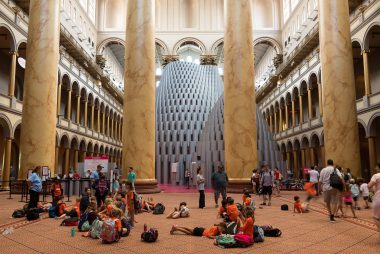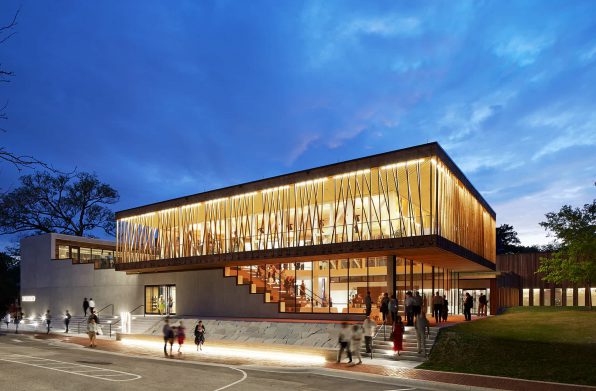MAS Context — "Converging at Architecture: An Interview with Jeanne Gang"
MAS Context publishes an excerpt from Studio Gang: Architecture (Phaidon, 2020) featuring an interview of Jeanne Gang by Architect Ann Lui, founding principal of Future Firm.
“In May 2018, almost seventy-five years after geologist Harold Fisk first mapped the sinuous, shifting courses of the Mississippi River, I watched Jeanne Gang repaint by hand the contours of the same waterway onto the wall of the U.S. Pavilion at La Biennale di Venezia, the 16th International Architecture Exhibition.1 While Fisk mapped the alluvial meandering of “Old Man River” on the brink of World War II, Jeanne was drawing for the exhibition Dimensions of Citizenship in a moment when the discipline of architecture was reckoning with resurgent, rising nationalism, and violent exclusion—echoes of Fisk’s era—combined with new forms of transnational capital, media, and ecological risk.
If Fisk revealed, at a precarious moment, the ultimately fragile nature of military and infrastructural control set against the river’s far longer geological history, Jeanne’s 2018 map embraced designing within those chimeric conditions. . . . This drawing captured one of the defining traits of Jeanne Gang’s approach: her ability to find the crucial moments in which layered conditions of nature, history, and culture converge at architecture—and therefore become a site of potential intervention through design. . . . Through Jeanne’s approach, architecture also becomes an act of stitching together complex conditions and collaborators to produce, if we’re lucky, opportunities to navigate forward into a built environment that is potentially more beautiful, and maybe even more equitable.
MATTER AND MATERIALS
Ann Lui: The stories about how you tested stone in tension for the Marble Curtain installation are very intriguing to me. By testing to failure, it seems like two things happened. First, a major opportunity between the expected and actual capacity was revealed. Second, and maybe to me more interesting, a kind of magic or myth arose—as the project’s lead mason is quoted as saying, ‘Word got out we were pulling stone apart and everyone came to watch.’ What are instances when testing and experimentation helped shape a project in an important way?
Jeanne Gang: When it comes to materials, you often learn more about them when you push them to their max and break them. The Marble Curtain project was exciting because we were working with people who said, “This will never work”—those were the material scientists. But we were also working with craftworkers who were sharing their hidden knowledge, like our lead mason, Matthew Redabaugh, who taught us that you can find a stone that’ll perform well if you thump it with your knuckle and it rings like a bell. It was stunning to learn that sound was this kind of indicator. Though it makes sense because you can do the same thing with a crystal champagne glass or things like—
AL: —a watermelon.
JG: Exactly. So the engineer who ran the testing lab may have been surprised that we were able to push the stone that far, but the same type that performed best in the tests was also the one that gave the clearest ring when struck by hand. . . . Other examples of testing to failure… We tried to break the wood battens of the Writers Theatre gallery walk by pulling them apart—although in that test, the battens never actually failed, so at a certain point we stopped testing, for fear that the steel armature that was holding the wood in place was going to break first!
AL: It seems important to you to find the gray area between material or structural failure and what you previously thought was a limit.
JG: And certain materials are so enigmatic; you just want to know more about them. Like stone. Compared to a fabricated material like the paper tubes, it’s magical, because it’s uniquely formed by weather, wind, or geologic forces. There are many types—or let’s call them species—of stone. In fact, we don’t even know how many exist. This kind of diversity is also what’s fascinating about wood. It’s about the individual grain, the knots, the amount of cellulose or lignin present in each species. . . . In this book, the title we gave to the family of projects that explore material in a particularly deep way is ‘What Are You Made Of?‘ It’s phrased as a question because that’s the attitude we bring to this aspect of our process. For Stone Stories, for example, we were asking that question quite literally—what could different geologic types of stone reveal?
AL: That’s one of the things I really like about Stone Stories in Dimensions of Citizenship. It sets up a question about the agency of rocks, which becomes a theme throughout the exhibition: how they can have different material properties but also a bigger significance culturally, historically.
JG: I wonder at all the ways we are connected to rocks: I mean, the fact that we have iron in our blood is because the earth was pelted by meteorites. From that collision, rocks, in a sense, became part of us. Everything that happens on the earth’s surface in terms of biological life is a result of the specific geological underpinning. When you look at it this way, rocks are much more alive than we might presume.”
Related
Studio Gang Publishes New Monograph with Phaidon
Published by Phaidon, Studio Gang: Architecture is a new monograph that captures the Studio’s pursuit of bold, optimistic architecture through an in-depth exploration of 25 signature projects and the resonant concepts that connect them.
Phaidon — "Watch Jeanne Gang Tell You About Her New Book"
“After all, as we all know, to experiment is to take risks, to open oneself to the vagaries of the unknown and the unpredictable. A bit like cycling through the streets of Chicago perhaps? One thing’s for sure: without experimentation there is no discovery; and Jeanne Gang, who founded this New York, Chicago, San Francisco and Paris-based practice twenty years ago, has discovered a lot.”






